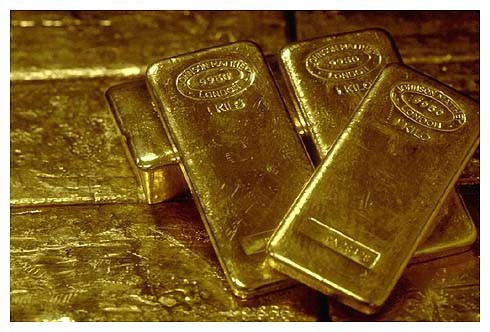The Better Inflation Hedge Gold or Treasuries
Post on: 25 Июль, 2015 No Comment

Posted by: American Hard Assets in Gold & Silver 3 hours ago
Sept 26 (Investopedia) — Rightly or not, gold is widely viewed as an inflation hedge — a reliable measure of protection against purchasing power risk. The precious metal may not be the best option for that purpose, though. Some gold investors fail to consider its volatility as well as its opportunity cost, while others fail to anticipate storage needs and other logistical complexities of gold ownership.
For these and other reasons, some view U.S. Treasury bills as a superior safe haven alternative to gold. Both asset classes have their own sets of pros and cons; here’s a look at them. (For more, see: How Much Disaster Can Gold Hedge? )
Gold or Treasuries?
Slow and Steady vs. Gold Fever
Like any other investment, gold fluctuates in price. Investors may have to wait long stretches to realize profits, and research shows that the majority of investors enter when gold it’s near a peak, meaning upside it limited and downside is more likely. Meanwhile, slow but steady Treasuries provide less excitement but reliable income. And the longer the gold is held over Treasuries, the more painful these opportunity costs can become, due to sacrificedcompound interest.
An arguably lesser but no-less present worry: some gold investors also must contend with the chore of safely storing their investment, by vaulting it at home or by acquiring a bank safe deposit box. But in either scenario, bullion coins that are held for one year or longer are classified as “collectibles” — similar to artwork, rare stamps or antique furniture. Whether the precious metal is in the form of an American Eagle gold coin, a Canadian Gold Maple Leaf coin or a South African Krugerrand, its sale automatically triggers a long-term federalcapital gains tax rate of approximately 28% — nearly double the 15% capital gains rate for typical stocks. (For more, see: Gold is a Great Hedge Today .)
All of that said, gold has fared better than silver, platinum, palladiumrecently, as well as most other precious metals. After hitting almost $ 1,900 per ounce in 2011, gold bottomed out at around $ 1,188 per ounce last December, and in March climbed to over $ 1,380 per ounce before leveling off at about $ 1,218 today. Gold’s rise this year is at least partially due to the formidable defense gold and silver presents against the eroding value of paper currency. But in light of this trajectory, many believe gold’s future performance is uncertain, and favor a shift to Treasuries. (For more, see: Curbing the Effects of Inflation .)
The Case for Treasuries
The biggest draw in buying Treasury bonds instead of gold is that the former locks in certain returns on investment. Prescient investors who saw fit to buy $ 10,000 in 30-year Treasury Bills in 1982, would have pocketed $ 40,000, when the notes reached maturity with a fixed 10.45% coupon rate. Of course, the days of double-digit percent coupons may be long gone. In January 2014, for example, the U.S. Treasury auctioned another round of 30-year bonds with just a 3% coupon. Nonetheless, such bonds cans still comprise a key element to any risk-averse portfolio. (For more, see: How Safe are U.S. Bonds? )
Gold ETFs an Option
Depending on your income level, Treasury investments are typically more favorable tax-wise. But gold investors may level the capital gains tax playing field by investing in gold exchange-traded-funds (ETFs), which are taxed exactly like typical stock and bond securities. Within the ETF framework, there are three distinct ways in which investors may participate. The first, gold mining ETFs, benchmark against mining companies, appealing to investors who are not interested in actual commodity ownership. An example of such an ETF is the Market Vectors Gold Miners ETF (GDX). (For more, see: Top Tips for Day-trading Gold ETFs and Hedge Inflation with Gold ETFs .)
The next, gold ETF futures, gain exposure to gold through futures contracts. Because these funds hold a combination of contracts and cash — usually parked in Treasury bills — they’re able to generate interest income to offset expenses. An example is AdvisorShares Gartman Gold/British Pound ETF (GGBP). Finally, there are pure-play ETFs, which strive to reflect the performance of gold bullion by directly investing in gold trusts. Bullion bars are purchased, stored in bank vaults and insured. While pure-play ETFs may track the bullion more closely, they have the disadvantage of being taxed more heavily than other versions. An example is PowerShares DB Gold Short ETN (DGZ). (For more, see: The Gold Showdown: ETFs vs. Futures and The 5 Best-Performing Gold ETFs .)
The Bottom Line
Knowing when to bow out of gold can be a tough call. As a hedge against inflation (and geopolitical risk), gold has ascended to great highs over the past decade, due to liberal central bank policies, such as the Federal Reserve’s recentquantitative easing programs. From here, gold could rally or fall further; no one can predict which way it will go. On the other hand, Treasuries take speculation (as well as some excitement) out mix. Savvy investors should take a sober look at gold versus Treasuries in their portfolios and construct an allocation mix that best suits their temperament and time horizon. (For related reading, see: How to Protect Yourself from Rising Interest Rates .)
For more precious metals updates, follow American Hard Assets on twitter: @hardassetsmag. Receive the latest news by joining us on Facebook. And be sure to give us plus one on Google Plus. Grab also a copy of our latest magazine issue .














